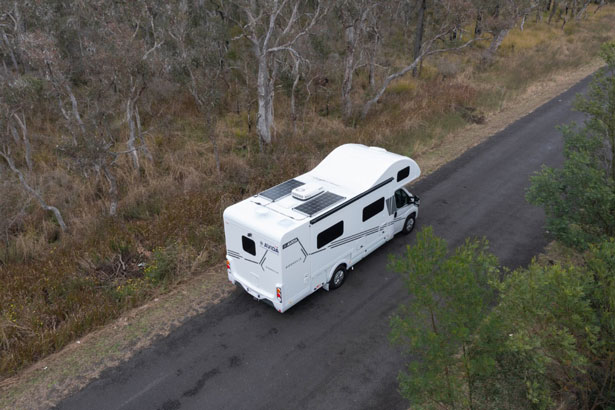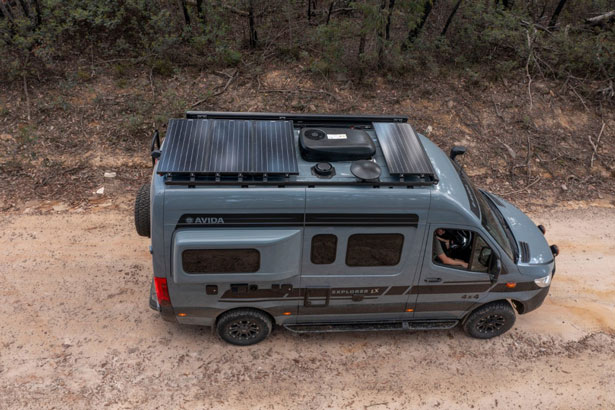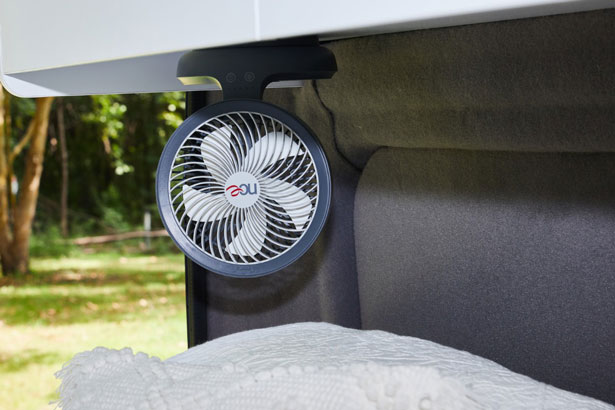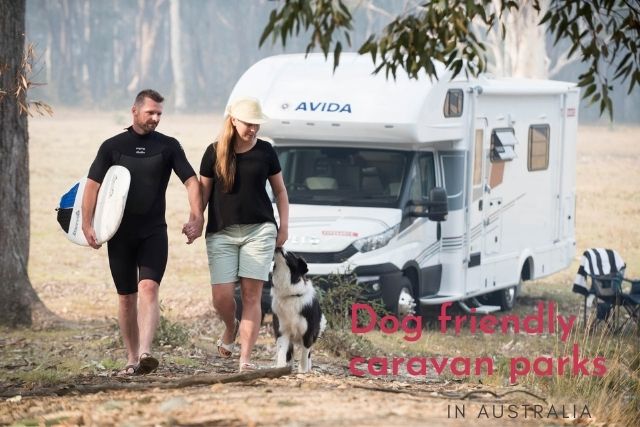
One of the best parts of owning a motorhome is the freedom to travel where you want, when you want. But when you’re setting up camp far from the conveniences of civilisation, keeping your appliances powered can be a challenge.
That’s where solar power comes in. Adding a solar system to your motorhome allows you to generate electricity no matter where the road takes you, giving you independence and peace of mind. But as solar systems and people’s motorhome setups grow more complex, it can be hard to know where to start and how everything fits together.
In this guide, we’ll take you through everything you need to know about how solar power works for motorhomes, from setup to how much energy you can expect to generate.
How Do Motorhome and Campervan Solar Systems Work?
Solar panels work by harnessing the sun’s energy and converting it into electricity that you can use to power lights, appliances, and even air conditioning. The panels are usually mounted on the roof of your motorhome to get the most light possible. There are generally two types of panels available in Australia: monocrystalline solar panels and polycrystalline solar panels. These panels contain photovoltaic (PV) solar cells made of semiconductors like silicon. When sunlight hits these cells, it creates an electric current.
This electricity, known as direct current (DC), flows through the cables to a charge controller. The charge controller regulates the power going into your motorhome’s batteries, preventing them from overcharging and ensuring they store the generated energy efficiently. Once the energy is stored in your battery bank, you can use it to power your devices and appliances whenever you need it.
If you want to run standard household appliances like microwaves, coffee makers, or even air conditioners, you’ll need an inverter. This handy piece of equipment converts the stored DC power into alternating current (AC), making it compatible with most household devices.
Portable Solar Panels vs Permanent Solar Systems

When it comes to solar systems for motorhomes, you have two main options: portable systems and permanent roof-mounted systems. Each has its pros and cons, so choosing the right one depends on what you need and how you’re planning to travel.
Portable solar systems are perfect if you want flexibility. They’re lightweight, easy to store, and generally the most affordable option if you’re only looking to power a few devices. You can get rigid or flexible solar panels, and they can be placed wherever the sunlight is best, even if your motorhome is parked in the shade.
Permanent systems of rigid solar panels are mounted directly onto the roof of your motorhome, providing consistent power without the need to position panels every time you stop. Whether you’re parked up or on the move, as long as the sun is shining, they’ll be generating power.
They’re ideal if you want to get off-grid for longer periods and prefer the convenience of a fixed setup. While they’re more expensive to install, they offer more robust and reliable power generation than portable solar panels. If you’re opting for a permanent setup, you’ll need to ensure your motorhome’s roof has enough space for the panels and is strong enough to support them as well.
How Much Power Can You Expect from Solar Panels?
The amount of power your motorhome or campervan solar system generates depends on several factors. Panel size and efficiency play a big role, with a 100-watt panel typically producing around 300 watt-hours of energy per day. Naturally, the more panels you have, the more power you can generate.
Sunlight exposure is another crucial factor. The more direct sunlight your panels receive, the more energy they’ll produce. Parking in the shade or cloudy days will reduce the efficiency of your panels, so it’s worth thinking about how you park and where you travel.
Battery capacity also matters. To make the most of your solar panels, you’ll need a reliable battery bank to store the energy they generate. The more battery storage you have, the more appliances you can power and the longer you can enjoy off-grid power without having to recharge.
As a rough guide, two 100-watt panels should be enough to power your lights, keep your phone and devices charged, and run small appliances like a microwave. If you’re looking to run air conditioning or larger electrical devices, you’ll need a more extensive setup with an inverter, more panels and higher-capacity batteries.
What Can You Power with a Motorhome Solar System?

The simple answer is that you can power just about anything, so long as you’ve actually got enough power!
For most travellers, essentials like lighting and fans is a breeze even with a very basic portable or fixed solar panel kit. Keeping your food and drinks fresh is also easily within reach, with most standard solar setups providing enough juice to keep your fridge and freezer running smoothly, even on longer trips.
As long as your solar setup includes an inverter, you can even power small kitchen appliances like coffee makers, toasters, and microwaves, to make life on the road just that little bit more convenient.
If you’re looking to power air conditioning, things get a bit trickier. Air con units draw a lot of energy, so if staying cool is a priority, you’ll need a larger setup with high-capacity panels and batteries. It’s definitely possible, but it’s worth chatting with a professional to make sure your system is designed to handle the load.
Planning Your Motorhome Solar Power System
Figure Out How Much Power You Need
Setting up a motorhome or campervan solar power doesn’t have to be complicated, but it’s worth planning properly before making any decisions. The first step is to figure out how much power you need. Start by listing everything you want to power, including lights, fridges, phones, laptops, coffee makers, and even air conditioning if you want that extra comfort.
To figure out how much power your appliances use, check their power rating labels or manuals. Most devices list their energy consumption in watts, so it’s just a matter of multiplying that number by the number of hours you plan to use them each day. For example, a 60-watt fridge running for 10 hours a day would consume 600 watt-hours of power daily. Once you’ve added up all your devices, you’ll have a rough idea of how much energy you need to generate each day to keep everything running smoothly.
Pre-Installed Solar or DIY: Which One Wins?
Is it better to buy a rig with solar already installed, or aim to set it up yourself? If you’re still in the shopping phase, the choice is yours!
A factory-fitted system offers convenience, professional installation, and a warranty, saving you the hassle of figuring out panel placement, wiring solar panels yourself, and worrying about compatibility.
It really comes down to whether you’re after a hassle-free, road-ready option or not. In that case, pre-installed solar panels are the way to go.
Are Motorhome Solar Panels Worth It?
Absolutely. Solar power is a clean, reliable source of energy that’s perfect for the Australian outdoors. Ultimately, solar charging helps you save on fuel and campsite fees and gives you the freedom to camp wherever you like without worrying about powered sites. Once you’ve invested in a good-quality solar setup, your power is free. And that’s hard to beat.
Embrace Solar-Powered Freedom With Avida
Avida offers a range of solar-equipped motorhomes, including our newest models, the Explorer LX, Trek, Beechworth and the Bruny. Explore our collection of luxury motorhomes and campervans for sale and experience true freedom on the road with Avida!



